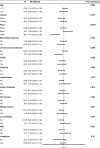Association of outcome with non-high-density lipoprotein cholesterol to high-density lipoprotein cholesterol ratio in hospitalized patients with congestive heart failure: a retrospective analysis
- PMID: 40713645
- PMCID: PMC12291406
- DOI: 10.1186/s13019-025-03551-2
Association of outcome with non-high-density lipoprotein cholesterol to high-density lipoprotein cholesterol ratio in hospitalized patients with congestive heart failure: a retrospective analysis
Abstract
Objective: To investigate the association between the Non-HDL cholesterol to HDL cholesterol ratio (NHHR) and all-cause mortality in patients with congestive heart failure (CHF) and to determine whether NHHR levels influence the prognosis of CHF patients.
Methods: The study participants were stratified based on the quartiles of NHHR. Kaplan-Meier (KM) curves, multivariate Cox regression analysis, and restricted cubic spline (RCS) analysis were employed to determine whether the prognosis of CHF patients varied according to NHHR levels.
Results: Our study included 2156 patients, of whom 274 (12.7%) died during hospitalization, 337 (15.6%) within 28 days, 480 (22.3%) within 90 days, and 665 (30.8%) within one year. Restricted cubic spline (RCS) analysis revealed a distinct U-shaped association between NHHR levels and mortality in CHF patients, characterized by an initial rapid decline followed by a gradual increase in mortality risk. Notably, patients in the lowest NHHR quartile (Q1) demonstrated significantly elevated 28-day, 90-day, and 1-year mortality rates (all P < 0.01, as confirmed by the Log-rank test) compared to the lower three quartiles, as confirmed by log-rank tests. Following the adjustment for confounding variables, multivariate Cox regression analysis established a substantial correlation between NHHR and all-cause mortality in CHF patients.
Conclusion: A virtually U-shaped link exists between NHHR and all-cause mortality in CHF patients, and further study is needed to corroborate this finding.
Keywords: Heart failure; Intensive care unit; Mortality; NHHR; Prognosis.
© 2025. The Author(s).
Conflict of interest statement
Declarations. Consent for publication: Not applicable. Competing interests: The authors declare no competing interests.
Figures



Similar articles
-
U-shaped relationship between the non-HDL to HDL cholesterol ratio and mortality in hypertensive individuals in the study from NHANES database.Sci Rep. 2025 Jul 1;15(1):20657. doi: 10.1038/s41598-025-07141-z. Sci Rep. 2025. PMID: 40596509 Free PMC article.
-
Association Between the Non-High-Density Lipoprotein Cholesterol-to-High-Density Lipoprotein Cholesterol Ratio (NHHR) and Mortality in Patients with COPD: Evidence From the NHANES 1999-2018.Int J Chron Obstruct Pulmon Dis. 2025 Mar 28;20:857-868. doi: 10.2147/COPD.S508481. eCollection 2025. Int J Chron Obstruct Pulmon Dis. 2025. PMID: 40171052 Free PMC article.
-
Associations between high-density lipoprotein cholesterol, non-high-density lipoprotein cholesterol, and their ratio with metabolic dysfunction-associated steatotic liver disease: a retrospective cohort study.Front Endocrinol (Lausanne). 2025 Jun 18;16:1585811. doi: 10.3389/fendo.2025.1585811. eCollection 2025. Front Endocrinol (Lausanne). 2025. PMID: 40607232 Free PMC article.
-
Dietary Approaches to Stop Hypertension (DASH) for the primary and secondary prevention of cardiovascular diseases.Cochrane Database Syst Rev. 2025 May 6;5(5):CD013729. doi: 10.1002/14651858.CD013729.pub2. Cochrane Database Syst Rev. 2025. PMID: 40326569 Review.
-
Omega 6 fatty acids for the primary prevention of cardiovascular disease.Cochrane Database Syst Rev. 2015 Nov 16;(11):CD011094. doi: 10.1002/14651858.CD011094.pub2. Cochrane Database Syst Rev. 2015. Update in: Cochrane Database Syst Rev. 2018 Jul 18;7:CD011094. doi: 10.1002/14651858.CD011094.pub3. PMID: 26571451 Updated.
References
-
- Savarese G, Becher PM, Lund LH, Seferovic P, Rosano GMC, Coats AJS. Global burden of heart failure: a comprehensive and updated review of epidemiology. Cardiovasc Res. 2023;118(17):3272–87. - PubMed
-
- O’Connor KD, Yamamoto Y, Sen S, Samsky MD, Wilson FP, Desai N, et al. Risk prediction for heart failure patients admitted to the intensive care unit: insights from REVeAL-HF. JACC Heart Fail. 2023;11(6):727–8. - PubMed
MeSH terms
Substances
LinkOut - more resources
Full Text Sources
Medical

